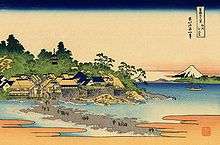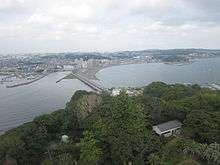Enoshima




Enoshima (江の島) is a small offshore island, about 4 km in circumference, at the mouth of the Katase River which flows into the Sagami Bay of Kanagawa Prefecture, Japan. Administratively, Enoshima is part of the mainland city of Fujisawa, and is linked to the eponymous Katase section of that city by a 600-metre-long (2,000 ft) bridge. Home to some of the closest sandy beaches to Tokyo and Yokohama, the island and adjacent coastline are the hub of a local resort area.
History
Benzaiten, the goddess of music and entertainment, is enshrined on the island. The island in its entirety is dedicated to the goddess, who is said to have caused it to rise from the bottom of the sea in the sixth century.[1] The island is the scene of the Enoshima Engi, a history of shrines on Enoshima written by the Japanese Buddhist monk Kōkei in 1047 AD.
In 1880, after the Shinto and Buddhism separation order of the new Meiji government had made the land available, much of the uplands was purchased by Samuel Cocking, a British merchant, in his Japanese wife's name. He developed a power plant and extensive botanical gardens including a very large greenhouse. Although the original greenhouse was destroyed in the 1923 Great Kantō earthquake, the botanical garden (now the Samuel Cocking Garden) remains an attraction with over half a million visitors a year.
Enoshima is now the center of Shōnan, a resort area along the coast of Sagami Bay.
Transportation
Enoshima is served by three nearby railway stations: Katase-Enoshima Terminus on the Odakyū Enoshima Line, Enoshima Station on the Enoshima Electric Railway ("Enoden"), and Shōnan-Enoshima Station on the Shonan Monorail.
Sport
Enoshima was the Olympic harbor for the 1964 Summer Olympics.[2] Enoshima will also be the sailing and surfing venue for the 2020 Summer Olympics.[3]
Notes
- ↑ Papinot (1972:82)
- ↑ 1964 Summer Olympics official report. Archived July 7, 2010, at the Wayback Machine. Volume 1. Part 1. p. 115.
- ↑ "東京五輪、26競技の会場決定 自転車・サッカー除き". Nihon Keizai Shimbun. 9 June 2015. Retrieved 9 June 2015.
References
- Papinot, E. (1910). Historical and Geographical Dictionary of Japan. 1972 printing. Tokyo: Charles E. Tuttle Company. ISBN 0-8048-0996-8.
- Sabin, Burritt (2002). A Historical Guide to Yokohama. Yokohama: Yurindo. ISBN 4-89660-172-6.
External links
| Wikimedia Commons has media related to Enoshima. |
-
 Enoshima travel guide from Wikivoyage
Enoshima travel guide from Wikivoyage - Enoshima Shrine
Coordinates: 35°17′59″N 139°28′49″E / 35.29972°N 139.48028°E
